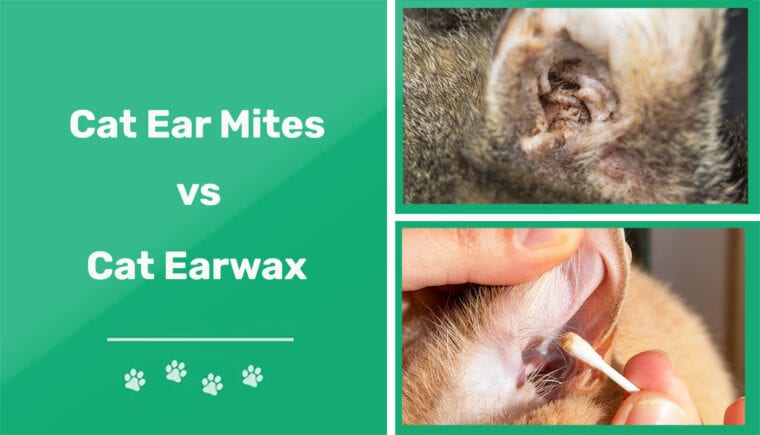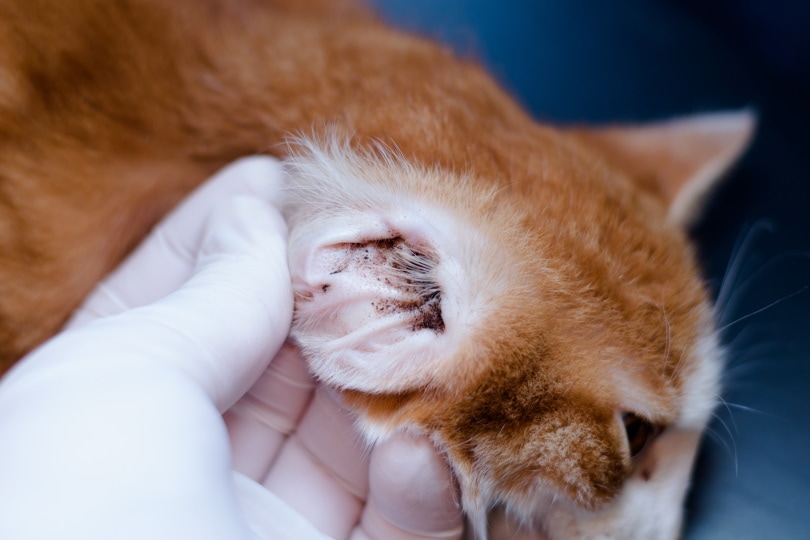
Click to Skip Ahead
Hearing is one of your cat’s most essential senses, and protecting their ears is vital. Healthy feline ears should be clean, odor-free, and not look red or irritated. There should be no sign of discharge, scratching, or discomfort.
Two common causes of ear problems in cats are ear mites and ear wax. Because they are treated differently, knowing which ear condition your cat is dealing with is essential. In this article, you’ll learn how to tell the difference between cat ear mites and ear wax and what to do about each issue.
Visual Differences

At A Glance
Overview of Ear Mites

What Are Ear Mites?
Ear mites are tiny parasites that reproduce inside an animal’s ear canal. Puppies and adult dogs can be infested with ear mites, but they are far more common in cats. The most common species of ear mites seen in cats is Otodectes cyanotis.
Although usually too small to be seen with the naked eye, you can sometimes spot ear mites crawling in your cat’s ear. However, it is easy to spot a cat with an infestation of ear mites, as they are very itchy, and the ear canal becomes full of the dark brown to black mess left behind by these wax-eating creatures. Ear mites are one of the most common ear conditions found in young cats.
How Do Cats Catch Ear Mites?
Cats catch ear mites by close contact with another infected animal. Ear mites are highly contagious. Besides dogs and cats, rabbits and ferrets can also develop ear mites. Kittens, especially newly adopted ones, and outdoor cats are the most vulnerable to ear mites, and they are a common problem in pet rescue centers.
Once ear mites infest your cat, they live primarily in the ear canal, feasting on wax and skin oil, and begin reproducing. Ear mites spend their entire 3-week life cycle on their host, in this case, your cat.

What Are the Signs of Ear Mites?
As we mentioned, you usually won’t be able to see the ear mites because they’re so small. The most common signs of an ear mite infestation include:
Ear mites are most often diagnosed by checking a sample of the discharge under a microscope. If your cat has ear mites, your vet will be able to see them.
How Are Ear Mites Treated?
Ear mites are typically treated with ear drops specifically formulated to eradicate these parasites. Several monthly cat flea control products, such as Revolution, can also be used to treat ear mites.
Your vet will help you determine which medication is best for your cat. Make sure to complete the entire course of treatment to ensure the ear mites are eradicated. If left untreated, an ear mite infestation can lead to ear infections and possibly damage to the ear.
Overview of Ear Wax

What Is Ear Wax?
Ear wax is a thick discharge or build-up in your cat’s ears. It can be cream, orange, brown, or black in color. Both indoor and outdoor cats develop ear wax.
What Causes Ear Wax?
Ear wax is produced naturally by the cat’s skin. It is most common in cats with seborrhea or oily skin. Cats with this condition secrete more oil from their sebaceous glands than normal, which can also lead to a buildup of ear wax.
What Are the Signs of Ear Wax?
Typically, you’ll spot ear wax pretty easily if you examine your cat’s ears. If the buildup gets thick or an ear infection is brewing, you may see your cat shaking their head, scratching or pawing at the ears, or tilting their head abnormally. Redness and odor are also signs of an ear infection.

How Is Ear Wax Treated?
Unless your cat develops an ear infection, ear wax can be easily treated by regular cleaning. Use an ear cleaner formulated for cats, and never stick cotton swabs or anything else into your cat’s ear canal. If your cat develops an ear infection, you must see your veterinarian for diagnosis and treatment.
Avoid cleaning your cat’s ears if they aren’t dirty, and you don’t see ear wax. Over-cleaning can irritate your cat’s ears and make them more vulnerable to infection. Many cats never develop ear wax or need to have their ears cleaned.
What Are the Differences?
The main differences between ear mites and ear wax are the color and texture of the discharge each condition produces and the level of discomfort. Ear mites are very itchy and uncomfortable, leading to intense scratching. By itself, ear wax is typically not painful unless it leads to an ear infection.
Cats of any age, indoor or outdoor, can develop ear wax. Ear mites are most common in kittens and outdoor cats. Ear mites need to be diagnosed and treated by a veterinarian, while ear wax generally doesn’t, again, unless it causes an ear infection.
Can You Prevent Ear Mites or Ear Wax?
You generally can’t prevent ear wax, as the cat’s skin glands naturally produce it. All you can do is clean it out when you do notice it. Keeping your cat indoors will help prevent ear mites, as will using antiparasitic treatments that also treat ear mites. Any contact with a cat (or dog) who goes outdoors could put your cat at risk of contracting ear mites. Be vigilant about checking outdoor pets for signs of ear mites.
If your cat spends time outside, make sure they receive regular topical parasite prevention. Many flea control products also help treat and prevent ear mites. Ask your vet to help you choose the right product for your cat.
If you adopt a new cat or kitten, separate them from your other pets for at least 2 weeks. This precaution helps ensure the new cat won’t introduce ear mites or other infectious diseases to your household.
When to See The Vet
If your cat has waxy ears but shows no other sign of itching, inflammation or discomfort, it is sensible to start with cleaning at home. If, however, you can’t seem to keep on top of the problem, or if your cat starts to show signs of discomfort, you should make an appointment to see your vet.
If you suspect that your cat has ear mites, they should be examined by a vet to confirm the diagnosis. Bacterial or fungal infections can have similar signs to ear mites, and require different treatments.
Never put anything down your cat’s ear canal without speaking to your vet. If there is damage to their ear drum, you could cause serious, even permanent damage to their hearing.

Conclusion
Ear problems are not as common in cats as in dogs, but when they occur, they need to be treated swiftly to prevent complications. An ear wax buildup can attract ear mites and lead to infection. However, you can monitor your cat’s ears as part of their regular grooming routine to help catch any problems early. If left untreated, ear mites and ear wax can lead to further issues such as infections, trauma from scratching, or even ear drum damage and deafness.
Featured Image Credit: (T) Todorean-Gabriel, Shutterstock | (B) Yaya Photos, Shutterstock








